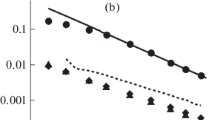Abstract.
A semiflexible harmonic chain model with extensible bonds is introduced and applied to the stretching of semiflexible polymers or filaments. The semiflexible harmonic chain model allows to study effects from bending rigidity, bond extension, discrete chain structure, and finite length of a semiflexible polymer in a unified manner. The interplay between bond extension and external force can be described by an effective inextensible chain with increased stretching force, which leads to apparently reduced persistence lengths in force-extension relations. We obtain force-extension relations for strong- and weak-stretching regimes which include the effects of extensible bonds, discrete chain structure, and finite polymer length. We discuss the associated characteristic force scales and calculate the crossover behaviour of the force-extension curves. Strong stretching is governed by the discrete chain structure and the bond extensibility. The linear response for weak stretching depends on the relative size of the contour length and the persistence length which affects the behaviour of very rigid filaments such as F-actin. The results for the force-extension relations are corroborated by transfer matrix and variational calculations.
Similar content being viewed by others
Explore related subjects
Discover the latest articles, news and stories from top researchers in related subjects.References
O. Kratky, G. Porod, Recl. Trav. Chim. 68, 1106 (1949).
R.A. Harris, J.E. Hearst, J. Chem. Phys. 44, 2595 (1966).
N. Saito, K. Takahashi, Y. Yunoki, J. Phys. Soc. Jpn. 22, 219 (1967).
M. Fixman, J. Kovac, J. Chem. Phys. 58, 1564 (1973).
J. Kovac, C.C. Crabb, Macromolecules 15, 537 (1982).
C. Bustamante, J.F. Marko, E.D. Siggia, S. Smith, Science 265, 1599 (1995).
S. Smith, Y. Cui, C. Butamante, Science 271, 795 (1996).
M. Rief, J.M. Fernandez, H.E. Gaub, Phys. Rev. Lett. 81, 4764 (1998).
T. Hugel, M. Grosholz, H. Clausen-Schaumann, A. Pfau, H. Gaub, M. Seitz, Macromolecules 34, 1039 (2001).
M. Rief, M. Gautel, F. Oesterhelt, J.M. Fernandez, H.E. Gaub, Science 276, 1109 (1997).
X. Liu, G.H. Pollack, Biophys. J. 83, 2705 (2002).
J.F. Marko, E.D. Siggia, Macromolecules 28, 8759 (1995).
P. Cluzel, A. Lebrun, R. Lavery, J.-L. Viovy, D. Chatenay, F. Caron, Science 271, 792 (1996).
T. Odijk, Macromolecules 28, 7016 (1995).
M.D. Wang, H. Yin, R. Landick, J. Gelles, S.M. Block, Biophys. J. 72, 1335 (1997).
C. Bouchiat, M.D. Wang, J.-F. Allemand, T. Strick, M. Block, V. Croquette, Biophys. J. 76, 409 (1999).
R.R. Netz, Macromolecules 34, 7522 (2001).
L. Livadaru, R.R. Netz, H.J. Kreuzer, Macromolecules 36, 3732 (2003).
B. Maier, U. Seifert, J.O. Rädler, Europhys. Lett. 60, 622 (2002).
R.G. Winkler, J. Chem. Phys. 118, 2919 (2003).
M. Doi, S.F. Edwards, The Theory of Polymer Dynamics (Oxford University Press, New York, 1986) p. 316.
B.-Y. Ha, D. Thirumalai, J. Chem. Phys. 106, 4243 (1997).
A. Lamura, T.W. Burkhardt, G. Gompper, Phys. Rev. E 64, 061801 (2001).
K. Kroy, E. Frey, Phys. Rev. Lett. 77, 306 (1996).
H. Kleinert, Path Integrals in Quantum Mechanics, Statistics and Polymer Physics (World Scientific, Singapore, 1995) pp. 370 and 590.
Alternatively \(\tilde{L}_{\rm p}=2\kappa/(d-1)T\), which includes the dimension-dependent factor 1/(d−1), is used as definition of the persistence length in the literature. We use the dimension-independent definition \(L_{\rm p} = 2\kappa/T\) in this paper.
P.J. Flory, Statistical Mechanics of Chain Molecules (Interscience, New York, 1969).
A. Ott, M. Magnasco, A. Simon, A. Libchaber, Phys. Rev. E 48, (1993) R1642.
W.H. Taylor, P.J. Hagerman, J. Mol. Biol. 212, 363 (1990).
P. Janmey, J.X. Tang, C.F. Schmidt, Actin filaments in Biophysics Textbook online, http://www.biophysics. org/btol/.
R.P Feynman, A.R. Hibbs, Quantum Mechanics and Path Integrals (McGraw-Hill, 1995).
V. Sa-yakanit, C. Kunsombat, O. Niamploy, Path Integral Approach to a Single Polymer Chain with Excluded Volume Effect, in Biological Physics 2000 (World Scientific, Singapore, 2001)
M. Abramowitz, A.I. Stegun, Handbook of Mathematical Functions (Natl. Bur. Stand., Washington, 1965).
E.M. Lifshitz, L.D. Landau, Theory of Elasticity (Pergamon Press, New York, 1986).
Author information
Authors and Affiliations
Corresponding author
Additional information
PACS:
87.15.-v Biomolecules: structure and physical properties - 87.15.Aa Theory and modeling; computer simulation - 87.15.La Mechanical properties
Rights and permissions
About this article
Cite this article
Kierfeld, J., Niamploy, O., Sa-yakanit, V. et al. Stretching of semiflexible polymers with elastic bonds. Eur. Phys. J. E 14, 17–34 (2004). https://doi.org/10.1140/epje/i2003-10089-3
Received:
Issue Date:
DOI: https://doi.org/10.1140/epje/i2003-10089-3




